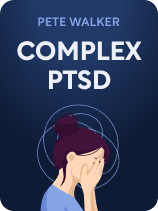

This article is an excerpt from the Shortform book guide to "Complex PTSD" by Pete Walker. Shortform has the world's best summaries and analyses of books you should be reading.
Like this article? Sign up for a free trial here.
Why is it important for survivors of abuse to grieve? Can PTSD be healed in the grief process?
PTSD and grief are connected because grieving allows you to feel and move through complex feelings of loss, anger, and sadness. There are distinct steps that you can follow to progress through the grieving process, separate from the well-known emotional stages of grief.
Keep reading for more on grief, trauma, and healing your emotional life.
Reconnecting With Emotions Through Grief
Overcoming the emotional damage of PTSD requires the survivor to reconnect with their feelings through grief. PTSD and grief are closely related. Grieving is a powerful experience that involves the full range of emotions—negative feelings like sorrow, as well as positive feelings like acceptance and hope for the future—and therefore it’s ideal for helping people break through emotional barriers.
(Shortform note: Although safe and long-term recovery from PTSD requires therapy, there are other ways for people to try reconnecting with their feelings. For instance, some mental health professionals suggest using books and movies to spark feelings of joy or grief. Fiction has the added benefit of being a relatively safe emotional outlet for survivors who aren’t ready to confront their own experiences yet.)
Grieving is also an important part of working through traumatic experiences and, eventually, recovering from them. Complex trauma survivors often need to grieve for the lost parts of their lives: for example, the love and safety they should have experienced, the feelings they should have been allowed to express, or the self-esteem they should have been encouraged to develop.
(Shortform note: It’s a common misconception that people only grieve after losing a loved one, but there are many different kinds of loss, and all of them can trigger feelings of grief. However, someone who’s mourning something besides a death—in this case, grieving for the life they should have had—often struggles because the people around them don’t think it’s a valid reason to grieve. As a result, instead of getting the understanding and emotional support they need during the grieving process, the survivor hears that they “shouldn’t” be mourning; having their feelings dismissed in this way only amplifies the pain of loss.)
The Grieving Process
There are four aspects of the grieving process when recovering from emotional trauma:
1. Sorrow: The survivor recognizes feelings of sadness along with their anger, and they vent those feelings by crying. Walker explains that crying is a powerful emotional release, as well as a self-soothing tool; it helps people let go of fear and shame so they can reach a healthier emotional state such as anger.
2. Anger: The survivor complains or rages about the abuse they endured and the parts of their life they lost. Doing so connects them with their feelings of anger and resentment; these are normal, healthy responses to unfair treatment. It also helps the survivor fight back against feelings of shame by placing blame where it belongs—on their abuser—and gets them accustomed to standing up for themselves.
3. Verbalizing: The survivor talks or writes about whatever they’re feeling at the moment, without judging themselves or censoring their words. The more emotional their language is, the more this technique helps them to connect with and express the feelings that they’ve been repressing. For survivors who are too disconnected from their emotions to verbalize them, talking about physical sensations (muscle tension, nausea, headaches, and so on) is also effective.
4. Experiencing: The other three aspects of grieving have been about actively expressing emotions—this final aspect means feeling those emotions without expressing them. In other words, the survivor is fully aware and accepting of their emotions and is able to experience those feelings while remaining in control of themselves. This is not to be confused with the emotional repression that’s common in CPTSD, where the survivor tries to stay in control by not feeling their negative emotions.
| How Does This Grieving Process Compare With the Five Stages of Grief? This description of the grieving process has some similarities to—and some notable differences from—the more common model of the five stages of grief, which was developed by psychiatrist Elisabeth Kübler-Ross: Denial: The first stage in Kübler-Ross’s model is denial. Denial is an instinctive response to something shocking or upsetting, such as the death of a loved one; people try to cope with overwhelming emotions by pretending that they’re not feeling those emotions in the first place, or that there’s no reason to feel that way. While the above described model of grief doesn’t specifically mention denial, this is what trauma victims are doing when they disconnect from their emotions or pretend to be happy, as if the traumatic experiences never happened to them. Anger: Anger is the second stage in both Kübler-Ross’s and our described models of grief. Anger is often the first emotion that people express when coming to terms with something upsetting or traumatizing, because getting angry allows them to release their feelings without leaving themselves emotionally vulnerable. In other words, anger is a “safe” emotion to express during a difficult time. Bargaining: Grieving people will often bargain with a higher power to take away their pain or to fix the situation that’s causing them grief; for example, they might promise never to drink again if their loved one recovers from a deadly illness. Although this model of grief doesn’t mention bargaining, it’s important to note that people turn to bargaining because they feel helpless to fix the situation themselves—much like how people with CPTSD feel when emotional memories of trauma pop up. Depression: According to Kübler-Ross’s model, depression happens when the grieving person starts coming to terms with the fact that they’re facing a great loss and there’s nothing they can do about it. People in this stage of grief tend to become withdrawn, avoiding their friends and loved ones during a time when they might need those connections the most. This model of grieving doesn’t mention depression, but recall that isolation and depression are common symptoms of CPTSD. The third step, verbalizing, is an important tool for people trying to overcome those symptoms. Acceptance: The final stage of Kübler-Ross’s model is acceptance, when the grieving person moves past depression and acknowledges that their loss is what it is. The person may still feel deep sadness, but they’re no longer fighting to change the situation through denial, anger, or bargaining. Though the above described model doesn’t use the term acceptance, this closely mirrors the final stage of the grieving process, when the survivor learns to understand and accept their own emotions. Although the two models of grief don’t directly line up with each other, this is because grieving is never a step-by-step process. Grieving people often bounce between the “stages” in no particular order—they might also keep circling back to a particular stage of grief or skip some of the stages entirely. |

———End of Preview———
Like what you just read? Read the rest of the world's best book summary and analysis of Pete Walker's "Complex PTSD" at Shortform.
Here's what you'll find in our full Complex PTSD summary:
- A guide to recognizing Complex Post-Traumatic Stress Disorder
- How to recover using physical, psychological, emotional, and social healing
- Why it's so important to accept and appreciate things that are "good enough"






